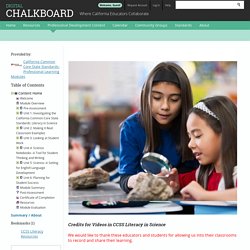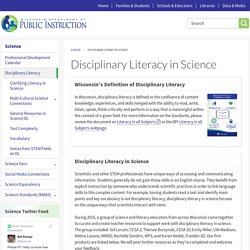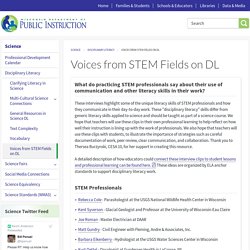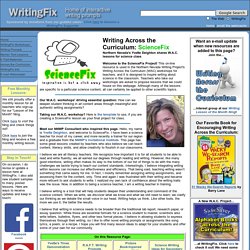

Northeast Georgia RESA - Science. Middle schools are served by both Northeast Georgia RESA and Oconee River GYSTC.

This page lists resources provided by RESA, as compiled by Jeremy Peacock, your RESA content specialist. For information on GYSTC, please visit their website or email jolaine.whitehead@negaresa.org. Earth Science Teacher Academy – This page provides information and resources for participants in the 2014-2015 Earth Science Teacher Academy registration is now closed, but the Academy will be offered again for the 2015-2016 school year. Presentations: Adolescent Literacy Toolkit. Adolescent Literacy Toolkit Mathematics Lesson Plans, Narratives, and Literacy Q&A Lesson Plans and Narratives The goal of the sample lesson plans is to show content-area high school teachers how they can use literacy strategies to help high school students learn core content and concepts.

NONFICTION MINUTE - HOME. Doing and Talking Math and Science. Reading Apprenticeship at WestEd – Middle School-High School Overview. The Naked Scientists. The Naked Scientists. STEM Read – Discover the Science Behind the Fiction. Can You Believe It? Seven Questions to Ask About Any Scientific Claim. Fermat's Library. News and feature articles from all fields of science. Seeds of Science/Roots of Reading. Learning Design Group. CCSS: Literacy in Science. Credits for Videos in CCSS Literacy in Science We would like to thank these educators and students for allowing us into their classrooms to record and share their learning.

Unit 2: Making it Real: Classroom Examples 1st GradeSara Rusche, Elementary Science Specialist Fred T. Korematsu Discovery Academy Rosemary McAtee, Principal Oakland Unified School District 5th GradeSusan Gomez Zwiep, CSU Long Beach (Visiting Teacher for Desi Valles) Glen View Elementary Cesar Carrasco, Principal Escondido Union School District 8th GradeKathy Marvin, California Teacher of the Year, 2010, & Science Department Chair Jeffrey Trail Middle School Scott Bowman, Principal Irvine Unified School District High SchoolHenry Shimojyo, Regular, Honors, and AP Chemistry teacher Lakeside High School Peter Hopping, Principal Lake Elsinore Unified School District. Community Resources for Science. The common thread of all the books on the CRS science book list is good writing and accurate science content.

The list is intended to assist teachers in selecting a few quality, well-reviewed, age-appropriate books for a given science topic. These books may be used as fundamental parts of a science unit or as enrichment to a unit. Our grade level list below is a starting place for looking for books to complement your science units. Sites Where You Can Find Great Science Literature Connections CRS Book List Jump to: First Grade / Second Grade / Third Grade / Fourth Grade / Fifth Grade Kindergarten. NGSS Resources. Www.physicscentral.com/experiment/colormephysics/index.cfm. Education in Chemistry. News and feature articles from all fields of science. Nonfiction Literacy and Current Events.
Science & Computer Science. Science Teachers of Missouri - Reading & Writing in Science (Wendy Saul) Wisconsin Department of Public Instruction. Scientists and other STEM professionals have unique ways of accessing and communicating information.

Students generally do not gain those skills in an English course. They benefit from explicit instruction by someone who understands scientific practices in order to link language skills to this complex content. Wisconsin Department of Public Instruction. What do practicing STEM professionals say about their use of communication and other literacy skills in their work?

These interviews highlight some of the unique literacy skills of STEM professionals and how they communicate in their day-to-day work. These "disciplinary literacy" skills differ from generic literacy skills applied to science and should be taught as part of a science course. We hope that teachers will use these clips in their own professional learning to help reflect on how well their instruction is lining up with the work of professionals.
We also hope that teachers will use these clips with students, to illustrate the importance of strategies such as careful documentation of work, peer review, clear communication, and collaboration. Thank you to Thersea Burzynski, CESA 10, for her support in creating this resource. A detailed description of how educators could connect these interview clips to student lessons and professional learning can be found here. STEM Professionals. Journal of Emerging Investigators. News and feature articles from all fields of science. ScienceFix: Writing Across the Curriculum...Science Resources. Writing Across the Curriculum: ScienceFix Northern Nevada's Yvette Deighton shares W.A.C. lessons for science class Welcome to the ScienceFix Project!

This on-line resource is used in the Northern Nevada Writing Project's Writing Across the Curriculum (WAC) workshops for teachers, and it is designed to inspire writing about science in the classroom. Teachers who take our workshops are asked to propose lessons that we could house on this webpage. Although many of the lessons are specific to a particular science content, all can certainly be applied to other scientific topics. Our W.A.C. workshops' driving essential question: How can we deepen student thinking in all content areas through meaningful and authentic writing assignments? Taking our W.A.C. workshop?
How to Read a Scientific Paper. Please ensure you have JavaScript enabled in your browser.

If you leave JavaScript disabled, you will only access a portion of the content we are providing. <a href="/science-fair-projects/javascript_help.php">Here's how. </a> Target Audience. Turbo Encabulator. WIPO - Search International and National Patent Collections. Publications for Young People and Schools. WIPO has produced a range of publications aimed at young people and schools.

These publications are designed to foster the creativity and inventiveness of future generations, while at the same time raising awareness about the value of intellectual property (IP). Inventions and Patents Inventions and Patents is the first publication in WIPO's Learn from the Past, Create the Future series for schoolchildren, the innovators of the future. It responds to the demand from member states for practical and detailed curriculum materials on IP, suitable for use in classrooms around the world.
Create a culture of innovation using patents in the science classroom. ScienceFix: Writing Across the Curriculum...Science Resources. Writing with Scientists with the American Museum of Natural History Home. Teaching Resources « Write Like a Scientist. Org-8: Test yourself Each of the following excerpts are taken out of context from journal article Discussion sections.

Assuming each excerpt as a whole accomplishes Move 2, identify which of the four sub-moves is accomplished by each sentence. Note that not every excerpt will contain all of the sub-moves. (Sentences are numbered with italicised superscript numerasl for reference in the Solutions.) 1. 2. 3. Conclusion 4 This study is the first to detect of B. microti in Danish ticks. 4. 8 These new results call for experimental verification. 9 At present we have to rely on our 3D PIC simulations. 10 However, we recall that PIC simulations have been very successful in reproducing existing experiments [12, 14, 34]. 11 The fast development of laser technology suggests that the laser pulses with corresponding parameters will be available in the near future.
Solutions.